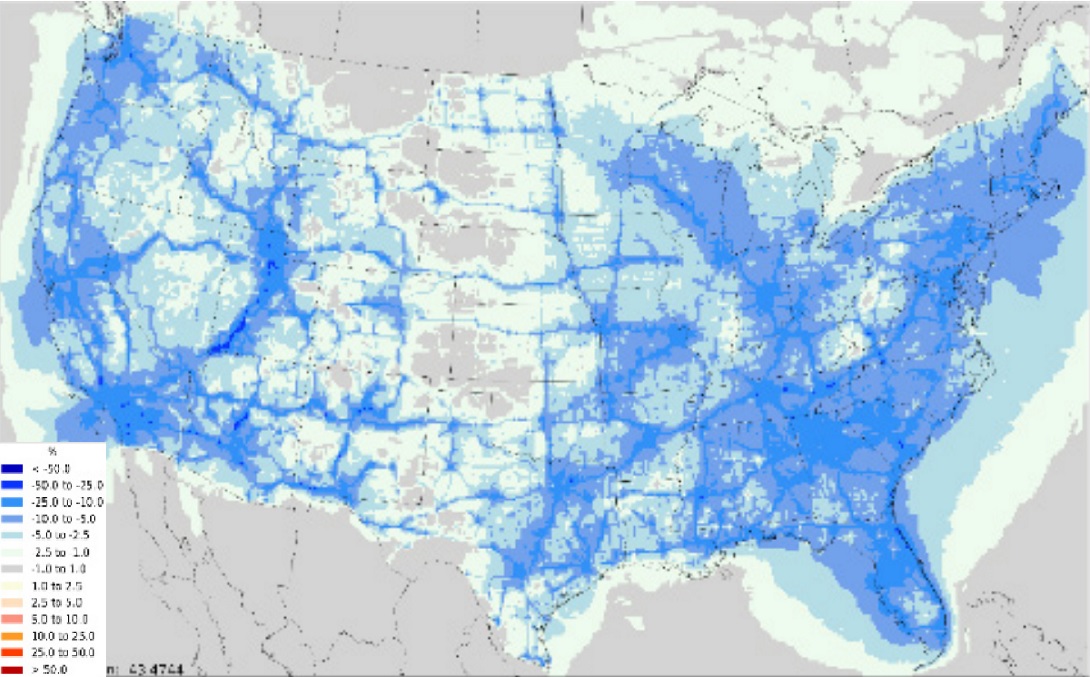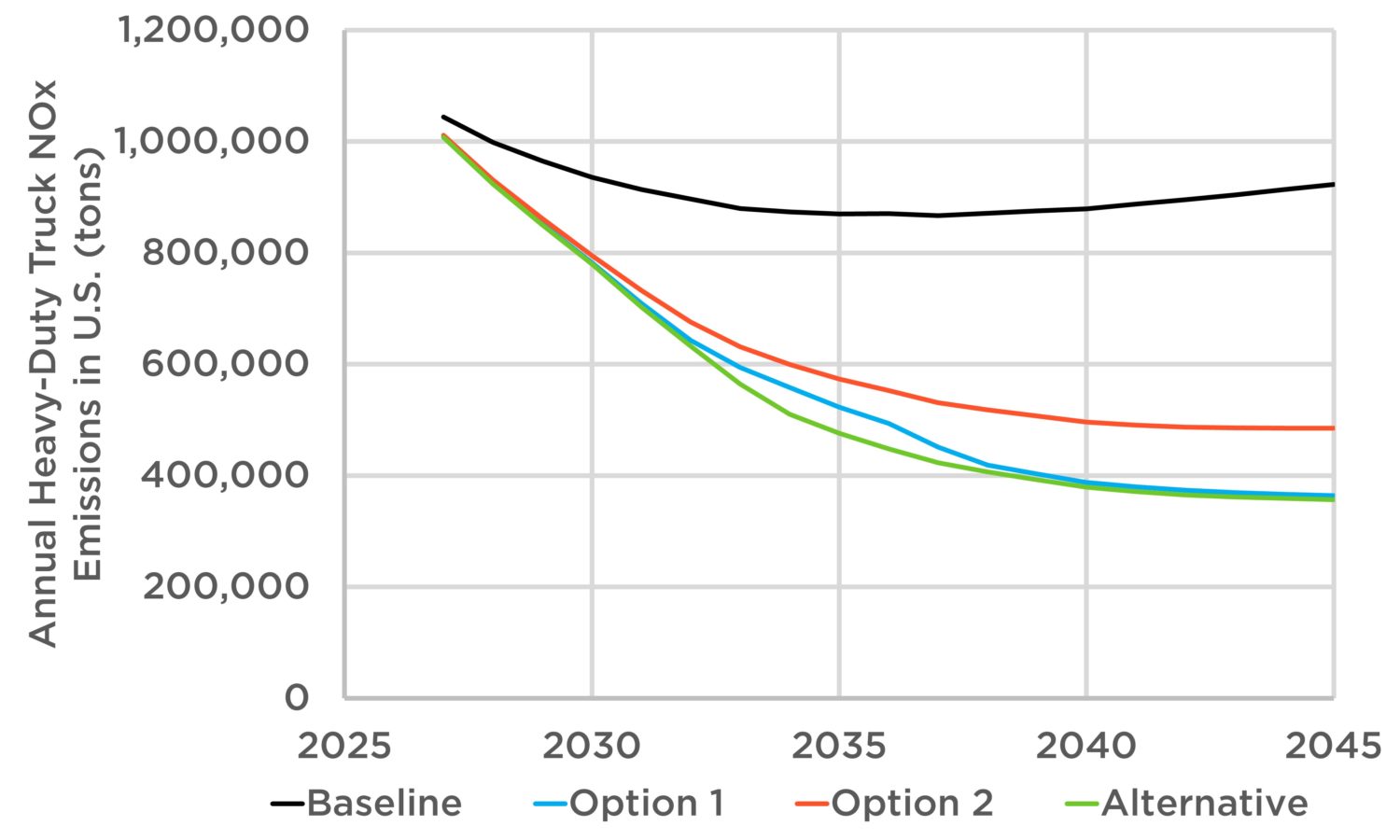For the first time in more than 20 years, the Environmental Protection Agency (EPA) is moving forward with stronger pollution standards for heavy-duty trucks. Though these trucks are just a small share of the total vehicles on the road, they are one of the largest sources of smog-forming and particulate pollution in the United States, resulting in disproportionate health impacts for communities living near highly trafficked areas like warehouses, ports, and freight corridors.
These trucks will be on the roads for decades, so it’s critical that EPA gets this rule right. The proposed rule comes as some states are moving forward with their own (stronger) regulations, and amid a full-on anti-regulatory assault from major truck manufacturers. Below, I dig into the rule, the positive changes, some areas where the administration fell short, and what we’re looking to strengthen before the rule is finalized.
EPA deferring on a preferred solution
Perhaps the most notable feature in today’s proposed rule is that it doesn’t actually have a clear proposal. In every previous rulemaking in which I’ve been involved, EPA has indicated a “preferred alternative” as well as other alternatives considered during the drafting of that proposal. Instead, for this rule EPA has two “co-proposed” alternatives, as well as a less fleshed out, more stringent alternative it considered. The two most solidified proposals on smog-forming nitrogen oxide (NOx) emissions reductions essentially represent on the one hand, strong state standards that have already gone through an extensive, multi-year stakeholder engagement process, and on the other hand, a wildly ridiculous proposal from the truck industry.
In addition to the NOx standards, for which EPA has based its rule exclusively on cleaning up diesel- and gasoline-powered engines, EPA is proposing small adjustments to its Phase 2 global warming emissions standards. Importantly, under none of these proposed standards does EPA look to accelerate the adoption of electrification in the heavy-duty truck industry.
Option one gets much right
Under the option one NOx emissions standards, EPA is largely adopting the same structure that California and other states are already implementing via the Heavy-Duty Omnibus (HDO) regulations finalized last year after a six-year rulemaking process . While the proposal does not fully align with that rule until 2031, a four-year delay, these rules would reduce allowable emissions of smog-forming nitrogen oxides (NOx) by 90 percent on today’s test procedures. Additionally, the proposal introduces a new low-load test cycle to better ensure that emissions controls are working effectively across the full range of operating conditions, especially at low speeds. Notably, most trucks operate at low speeds near the ports and warehouse districts most directly impacting overburdened local communities. Previously ignored, this low-load operation could account for more than half of the NOx emissions from a typical truck according to EPA’s own data.


In addition to better capturing real-world operation on the regulatory tests, EPA is proposing to improve real-world monitoring and emissions limits. Part of the reason emissions controls aren’t working as well as intended is that they aren’t required to! Current real-world confirmatory regulatory procedures test less than 10 percent of truck operation against the vehicle’s required emissions targets. The reason for this is an outdated requirement that (in theory) was supposed to measure only typical engine operation and is instead rejecting far more common, dirtier operating conditions. To fix this, EPA is adopting an approach based on what is already used in Europe and is currently required in the state of California, which more accurately reflects most real-world operation. This new approach will consider virtually all real-world operation and ensure that the standard is being met as required under such conditions.
Lastly, EPA is proposing to extend requirements around warranty and useful life. 90 percent of tractor-trailer engines are driven on the road for nearly 800,000 miles, and fully half see 1.2 million miles. Yet currently, the warranties covering emissions controls are required to be just 100,000 miles, and the assumed full-useful life of a Class 8 diesel engine is just 435,000 miles, barely half what virtually every such engine will see over its lifetime. Even well-maintained engines see significant deterioration over time—and currently, manufacturers are only responsible for what happens in less than half of the typical lifetime of a diesel engine. And unfortunately, that means unrestricted pollution for the vehicles with the most mileage, exactly the vehicles that are most likely to be used in short-range operations and driving in and around port communities.
Why is there an option two?
In its proposal, EPA included a regulatory analysis based on option one that clearly shows the benefits of strong emissions regulation, including for communities of color and low-income communities. It also noted that over 72 million individuals live within 200 meters of a truck freight route in the United States—finalizing an alternative at least as stringent as Option 1 means up to a 60 percent reduction in NOx emissions from heavy-duty trucks by 2045 and up to 1600 lives saved annually, including many in the areas hit hardest by poor air quality thanks, in large part, to heavy trucks. Option 1 shows greater emissions reductions, cost savings, and so many more benefits compared with Option 2. The agency itself even notes that “Option 1 may be a more appropriate level of stringency … consistent with [its] authority under [the] Clean Air Act!” With all these benefits, it begs the question: Why the heck wasn’t Option 1 proposed by itself? Why is EPA even considering anything as weak as Option 2?

The clearest rationale can be found in my previous blog: industry pressure. EPA is claiming some uncertainty around the technical feasibility of some of the most stringent aspects of its rule, but that is simply parroting industry’s scaremongering. Industry groups representing truck drivers, manufacturers, and dealers are dead set against the type of regulations needed to clean up the impacts of our freight sector. They have commissioned bogus studies and threatened lawsuits in opposition of these regulations, shouting preposterous Chicken Little-isms about how they can’t possibly do what is obviously technically feasible and legally required. And with the world focused on rising oil prices—and perhaps now a trucking industry that has moved far too slowly to reduce oil use—industry is trying to play politics with the lives of millions of families in the United States, for profit.
Option 1 is the bare minimum that is needed to limit the impacts of the trucking industry—that EPA is even putting up for consideration a proposal in line with industry’s request for weaker standards is appalling and absolutely inconsistent with the requirements of the Clean Air Act. We will be using every avenue possible to ensure that EPA finalizes a rule at least as protective as Option 1 and is not weakened in any way consistent with the completely bogus and unjustifiable Option 2.
What about electric trucks?
Electric trucks are virtually missing from EPA’s action, which is clearly a missed opportunity. There has been continued growth in the electric truck market, and six states have adopted requirements on the sale of electric trucks, something we even presented to EPA in the regulatory review process. Unfortunately, the agency has drafted a proposal lagging what these rules and the market are putting on the road. In fact, EPA considered only a paltry 1.5 percent assumed electric truck sales in 2027, while state action puts the status quo requirements upwards of 10 percent in that timeframe!
While EPA has considered electric trucks feebly in its global warming emissions part of the proposal, it has completely ignored the opportunity to accelerate the adoption of electric trucks to eliminate the harmful tailpipe pollution plaguing local communities. Even worse, that did not prevent the agency from creating an opportunity to credit electric trucks, which could yield windfall credits for manufacturers that lead to even dirtier diesel vehicles being sold.
While EPA recognizes that NOx and particulate pollution from heavy-duty trucks is killing people across the country, in setting these standards they have ignored the one technology which those communities most affected by truck pollution have been pushing for. Environmental justice groups have been shouting from every corner the critical need to move to zero emissions solutions now. EPA must not respond to this request with silence.
EPA should be embracing the lessons learned in a complementary approach—states have balanced their rules by setting a minimum level of electric truck adoption while encouraging simultaneous reductions in emissions from the remaining diesel vehicles. EPA could adopt this approach to pull the market forward with the goal of achieve 100 percent zero emission truck sales by 2035, not propose rules that lag behind the status quo. Simultaneously addressing public health and climate change demands the rapid adoption of electric trucks.
Now the hard work begins
Over the next two months, we will be putting together as much data as possible on the benefits of setting strong emissions standards. We will focus on tightening the lifetime emissions from the trucks covered under this program and crafting greater certainty around the accelerated deployment of electric trucks, both of which aim to improve the real-world outcomes for communities overburdened by truck pollution, as these trucks are phased in and, importantly, over their entire lifecycle.
The health impacts of NOx pollution are devastating—we need to make sure that EPA is upholding its mandate under the Clean Air Act to do the maximum possible to address truck pollution.
And I hope you’ll join us in speaking out, so stay tuned for actions that we’ll send out over the next couple weeks. UCS will be using every avenue available to advocate for strengthening this rule, and we hope you will join the chorus in support.

